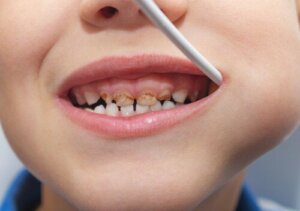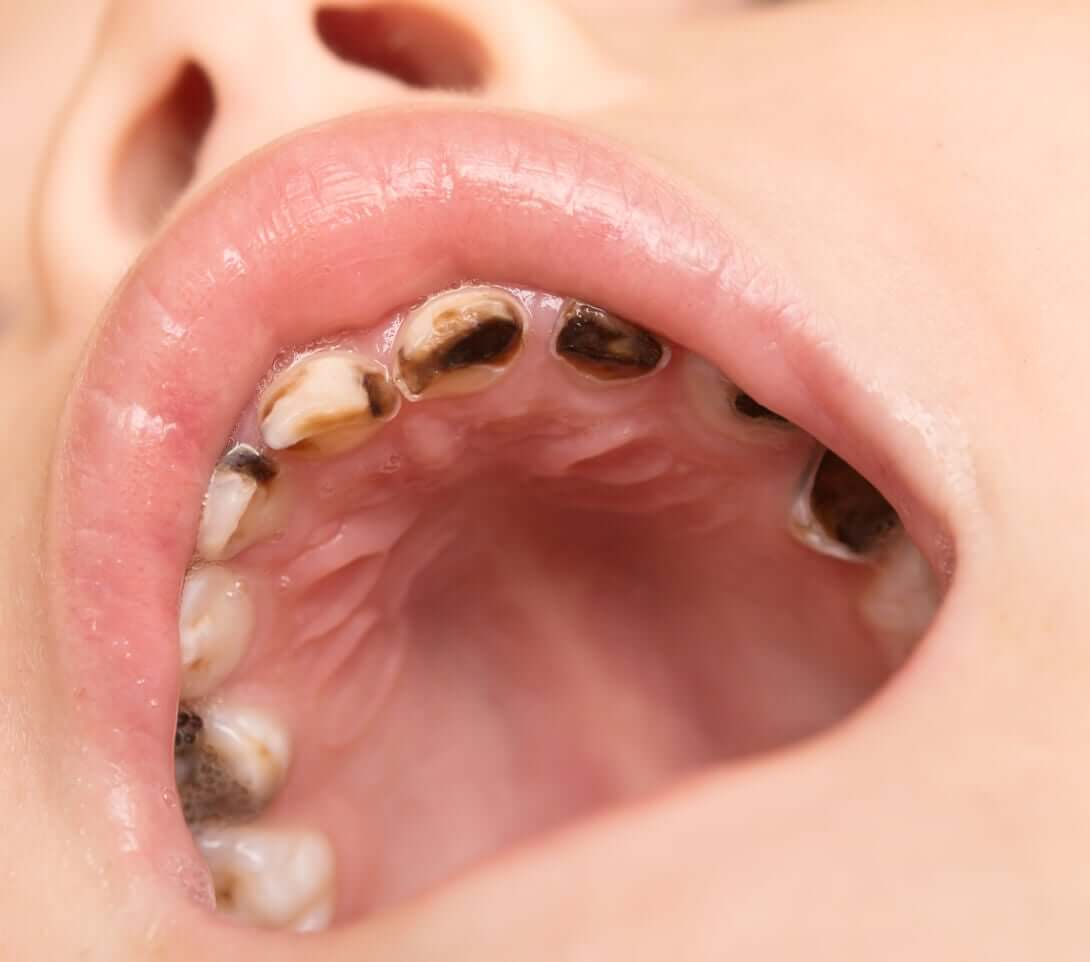Why Does My Child Have a Darkened Baby Tooth?

If you notice in your child has a darkened baby tooth, it’s normal for you to be scared and worried. After all, the change of coloration in a tooth is an alarm sign that shouldn’t be ignored.
Just the same, this situation is quite frequent in children and you should consult a trusted pediatric dentist to find a suitable solution.
In this article, we’ll tell you the causes of tooth darkening, how to treat it, and what you can do to avoid it.
Causes for having a darkened baby tooth
The natural color of temporary teeth ranges from greyish white to very subtle yellowish. But this coloration can darken to even turn completely black.
Most of the time, the cause of a darkened baby tooth is a dead dental pulp. The inner portion of the tooth can become necrotic after dental trauma or the presence of cavities.
In both situations, this color change occurs progressively, so it’s important for parents to keep an eye on the appearance of their little one’s teeth.
There are other situations that can change the tone of teeth, such as tartar, the consumption of iron supplements, and stains due to food pigments.
Below, we’ll explain each one of them in detail so you know what to watch out for.
Dental trauma

It’s quite common for children to suffer accidents while doing sports or while playing. Falls and blows to the mouth traumatize the teeth and can alter their blood supply. In general, the upper central incisors are the most affected.
The pulp of the tooth is the central area of the tooth and in it are the nerves and blood vessels. After an intense blow, this tissue can become inflamed and even irreversibly damaged.
Non-vital dental elements tend to darken as time passes. In this sense, the color change may not be immediate and may become apparent 2 or 3 weeks after the accident occurred.
It’s important to go to the dentist as soon as there is trauma to a dental tooth or if you notice even the slightest change in its color. Many times, the impact can cause damage to the definitive elements that develop inside the bone.
Cavities
The bacteria in the mouth ferment the carbohydrates we consume and produce an acid capable of destroying the hard tissues of the teeth. This demineralization is known as tooth decay.
If not treated in time, this disease progresses to destroy all dental tissues. At first, spots appear and then holes appear on their surfaces. These blemishes can turn dark and give the affected teeth a blackish appearance.
If the bacteria reach the pulp, it can cause its death and the consequent devitalization of the tooth also causes it to darken. In addition, the risk of injury to the permanent parts underneath increases.
How to act if your child has a darkened baby tooth?
As we’ve already mentioned, if you notice a change in color in a baby tooth of your child, go immediately to the pediatric dentist. The professional can evaluate the situation, determine the origin of the problem, and choose the best treatment for each case.
During the oral exam the dentist looks for other symptoms, such as the mobility of the tooth, the presence of pain, or pus.
The professional may consider it appropriate to take an X-ray to assess the condition of the tissues surrounding the dental element. This information allows you to assess the severity of the trauma and define what to do next.
Finally, if there are no symptoms, it’s important to inform the specialist of the traumatic event and tell them how the tooth has evolved since then.
Treatments for a darkened baby tooth
The treatment for a darkened milk tooth depends on the particularities of the case.
If the cause of the color change is the death of the pulp, the dentist must evaluate if an infection exists or not:
- If there’s an associated infection: The treatment to choose is the endodontics of the baby tooth or its extraction, depending on the time remaining for the replacement, the degree of destruction of the surrounding tissues, or the severity of the case. The use of antibiotics in this context may be necessary.
- If there’s no infection: Root canals or extraction can be performed, or watchful waiting and regular tooth monitoring can be done. Many times, the piece falls off by itself.
In the case of cavities, these must be eliminated by cleaning the area and creating a filling.
Finally, if the dark color of the baby tooth is due to superficial stains, they’re removed with a professional cleaning.

How to prevent darkened baby teeth
One way to avoid the appearance of a darkened baby tooth is to visit the dentist frequently, as the professional can detect those problems that parents sometimes can’t see.
In cases where a color change is detected in the baby teeth, timely consultation with the dentist improves the prognosis of the situation. Therefore, when faced with a blow to the mouth, no matter how harmless it may seem, a consultation is essential to determine the severity.
Another way to prevent the darkening of baby teeth is by removing the bacterial plaque that causes cavities, tartar, and stains. Brushing a child’s teeth three times a day with fluoridated toothpaste, flossing, and eating a low-sugar diet are key to caring for your mouth.
In addition, the use of mouthguards during sports or activities where falls are frequent is also very helpful.
Although some of these causes can’t always be avoided, the important thing is to offer the best support to the child to prevent major problems.
If you notice in your child has a darkened baby tooth, it’s normal for you to be scared and worried. After all, the change of coloration in a tooth is an alarm sign that shouldn’t be ignored.
Just the same, this situation is quite frequent in children and you should consult a trusted pediatric dentist to find a suitable solution.
In this article, we’ll tell you the causes of tooth darkening, how to treat it, and what you can do to avoid it.
Causes for having a darkened baby tooth
The natural color of temporary teeth ranges from greyish white to very subtle yellowish. But this coloration can darken to even turn completely black.
Most of the time, the cause of a darkened baby tooth is a dead dental pulp. The inner portion of the tooth can become necrotic after dental trauma or the presence of cavities.
In both situations, this color change occurs progressively, so it’s important for parents to keep an eye on the appearance of their little one’s teeth.
There are other situations that can change the tone of teeth, such as tartar, the consumption of iron supplements, and stains due to food pigments.
Below, we’ll explain each one of them in detail so you know what to watch out for.
Dental trauma

It’s quite common for children to suffer accidents while doing sports or while playing. Falls and blows to the mouth traumatize the teeth and can alter their blood supply. In general, the upper central incisors are the most affected.
The pulp of the tooth is the central area of the tooth and in it are the nerves and blood vessels. After an intense blow, this tissue can become inflamed and even irreversibly damaged.
Non-vital dental elements tend to darken as time passes. In this sense, the color change may not be immediate and may become apparent 2 or 3 weeks after the accident occurred.
It’s important to go to the dentist as soon as there is trauma to a dental tooth or if you notice even the slightest change in its color. Many times, the impact can cause damage to the definitive elements that develop inside the bone.
Cavities
The bacteria in the mouth ferment the carbohydrates we consume and produce an acid capable of destroying the hard tissues of the teeth. This demineralization is known as tooth decay.
If not treated in time, this disease progresses to destroy all dental tissues. At first, spots appear and then holes appear on their surfaces. These blemishes can turn dark and give the affected teeth a blackish appearance.
If the bacteria reach the pulp, it can cause its death and the consequent devitalization of the tooth also causes it to darken. In addition, the risk of injury to the permanent parts underneath increases.
How to act if your child has a darkened baby tooth?
As we’ve already mentioned, if you notice a change in color in a baby tooth of your child, go immediately to the pediatric dentist. The professional can evaluate the situation, determine the origin of the problem, and choose the best treatment for each case.
During the oral exam the dentist looks for other symptoms, such as the mobility of the tooth, the presence of pain, or pus.
The professional may consider it appropriate to take an X-ray to assess the condition of the tissues surrounding the dental element. This information allows you to assess the severity of the trauma and define what to do next.
Finally, if there are no symptoms, it’s important to inform the specialist of the traumatic event and tell them how the tooth has evolved since then.
Treatments for a darkened baby tooth
The treatment for a darkened milk tooth depends on the particularities of the case.
If the cause of the color change is the death of the pulp, the dentist must evaluate if an infection exists or not:
- If there’s an associated infection: The treatment to choose is the endodontics of the baby tooth or its extraction, depending on the time remaining for the replacement, the degree of destruction of the surrounding tissues, or the severity of the case. The use of antibiotics in this context may be necessary.
- If there’s no infection: Root canals or extraction can be performed, or watchful waiting and regular tooth monitoring can be done. Many times, the piece falls off by itself.
In the case of cavities, these must be eliminated by cleaning the area and creating a filling.
Finally, if the dark color of the baby tooth is due to superficial stains, they’re removed with a professional cleaning.

How to prevent darkened baby teeth
One way to avoid the appearance of a darkened baby tooth is to visit the dentist frequently, as the professional can detect those problems that parents sometimes can’t see.
In cases where a color change is detected in the baby teeth, timely consultation with the dentist improves the prognosis of the situation. Therefore, when faced with a blow to the mouth, no matter how harmless it may seem, a consultation is essential to determine the severity.
Another way to prevent the darkening of baby teeth is by removing the bacterial plaque that causes cavities, tartar, and stains. Brushing a child’s teeth three times a day with fluoridated toothpaste, flossing, and eating a low-sugar diet are key to caring for your mouth.
In addition, the use of mouthguards during sports or activities where falls are frequent is also very helpful.
Although some of these causes can’t always be avoided, the important thing is to offer the best support to the child to prevent major problems.
All cited sources were thoroughly reviewed by our team to ensure their quality, reliability, currency, and validity. The bibliography of this article was considered reliable and of academic or scientific accuracy.
- Rodríguez, S. A. V., Mena, A. G., Sepúlveda, A. G. R., & Elizondo, R. T. (2018). Necrosis pulpar con lesión periapical. Revista Mexicana de Estomatología, 5(2), 18-23.
- Alvarez Arana, D. R. (2017). RELACIÓN ENTRE EL DIAGNÓSTICO Y EL TRATAMIENTO DE LA PATOLOGÍA PULPAR EN DIENTES DECIDUOS DE PACIENTES NIÑOS QUE ACUDIERON A LA CLÍNICA ESTOMATOLÓGICA DE LA UNIVERSIDAD DE HUÁNUCO EN EL AÑO 2017.
- Pérez de Mora, E. (2018). Traumatismos en dentición primaria. Secuelas postraumáticas en dentición permanente: Revisión sistemática.
- Suarez Acebo, E. (2018). Repercusiones en los dientes primarios traumatizados debido a daños en la pulpa dental (Bachelor’s thesis, Universidad de Guayaquil, Facultad Piloto de Odontología).
- Canale, L. M., Rimoldi, M. L., Mendes, C. A., Mazzeo, D. M. A., Fernández, R., Iriquin, M. V., … & Fingermann, G. F. (2020). Tratamientos endodónticos en dientes temporarios: alternativas aplicables del nuevo milenio. Revista de la Facultad de Odontología, 2020.
- Oliveira-del Rio, J. A., Mendoza-Castro, A. M., & Alvarado-Solórzano, A. M. (2017). Endodoncia en dientes temporales. Pulpotomía. Polo del Conocimiento, 2(6), 1288-1297.
- Jumbo Jumbo, A. A. (2020). Prevalencia de lesiones pulpares en dientes temporales (Bachelor’s thesis, Universidad de Guayaquil. Facultad Piloto de Odontología).
- Carrasco Ostos, R. I. (2017). Manejo de terapia pulpar en dientes deciduos y permanentes jóvenes.
- Morales Chaucalá, V. A. (2019). Pasta triantibiótica en tratamiento de necrosis pulpar en dientes temporales (Bachelor’s thesis, Universidad de Guayaquil. Facultad Piloto de Odontología).
This text is provided for informational purposes only and does not replace consultation with a professional. If in doubt, consult your specialist.








